Prediction of Sites with a High Probability of Wild Mammal Roadkill Using a Favourability Function
Abstract
1. Introduction
2. Materials and Methods
2.1. Study Area
2.2. Collection of Roadkill Data
2.3. Model Preparation
2.3.1. Explanatory Variables
2.3.2. Response Variable
2.3.3. Predictive Models
2.3.4. Model Evaluation
2.3.5. Model Validation
3. Results
3.1. Records of Roadkill Presence
3.2. Predictive Models
3.3. Most Important Environmental Variables
3.4. Model Evaluation
3.5. Model Validation
4. Discussion
5. Conclusions
Supplementary Materials
Author Contributions
Funding
Institutional Review Board Statement
Informed Consent Statement
Data Availability Statement
Acknowledgments
Conflicts of Interest
References
- Forman, R.T.; Sperling, D.; Bissonette, J.A.; Clevenger, A.P.; Cutshall, C.D.; Dale, V.H.; Fahrig, L.; France, R.L.; Goldman, C.R.; Heanue, K. Road Ecology: Science and Solutions; Island Press: Washington, DC, USA, 2003; ISBN 1-55963-933-4. [Google Scholar]
- Barri, F.R. Evaluación Preliminar de La Mortandad de Mastofauna Nativa Por Colisión Con Vehículos En Tres Rutas Argentinas. Ecol. Appl. 2010, 9, 161–165. [Google Scholar] [CrossRef]
- Benítez-López, A.; Alkemade, R.; Verweij, P.A. The Impacts of Roads and Other Infrastructure on Mammal and Bird Populations: A Meta-Analysis. Biol. Conserv. 2010, 143, 1307–1316. [Google Scholar] [CrossRef]
- Puc-Sánchez, J.; Delgado-Trejo, C.; Mendoza-Ramírez, E.; Suazo-Ortuño, I. Las Carreteras Como Una Fuente de Mortalidad de Fauna Silvestre En México. CONABIO Biodiversitas 2013, 11, 12–16. [Google Scholar]
- Van der Ree, R.; Smith, D.J.; Grilo, C. (Eds.) Handbook of Road Ecology; Wiley-Blackwell: Hoboken, NJ, USA; Chichester, UK, 2015; ISBN 978-1-118-56816-3. [Google Scholar]
- Cervantes-Huerta, R.; Escobar, F.; García-Chávez, J.H.; González-Romero, A. Atropellamiento de Vertebrados En Tres Tipos de Carretera de La Región Montañosa Central de Veracruz, México. Acta Zool. Mex. 2017, 33, 472–481. [Google Scholar] [CrossRef]
- Villanueva-Vázquez, G.E.; Aguilar-Herrera, V.; Jaimes-López, R.; Nigenda-Quezada, M.; Rios, E. Biología y Sociedad. Facultad de Ciencias Biológicas; Universidad Autónoma de Nuevo León: San Nicolas de los Garza, Mexico, 2018; pp. 45–54. [Google Scholar]
- Grilo, C.; Bissonette, J.A.; Santos-Reis, M. Spatial–Temporal Patterns in Mediterranean Carnivore Road Casualties: Consequences for Mitigation. Biol. Conserv. 2009, 142, 301–313. [Google Scholar] [CrossRef]
- George, L.; Macpherson, J.; Balmforth, Z.; Bright, P. Using the Dead to Monitor the Living: Can Road Kill Counts Detect Trends in Mammal Abundance? Appl. Ecol. Environ. Res. 2011, 9, 27–41. [Google Scholar] [CrossRef]
- D’Amico, M. On the Road: Los Distintos Impactos Del Tráfico Motorizado Sobre Poblaciones Animales; Universidad Pablo de Olavide: Sevilla, Spain, 2015. [Google Scholar]
- Seiler, A.; Helldin, J. Mortality in wildlife due to transportation. In The Ecology of Transportation: Managing Mobility for the Environment; Springer: Berlin/Heidelberg, Germany, 2006; pp. 165–189. [Google Scholar]
- Ford, A.T.; Fahrig, L. Diet and Body Size of North American Mammal Road Mortalities. Transp. Res. Part Transp. Environ. 2007, 12, 498–505. [Google Scholar] [CrossRef]
- Ontario Road Ecology Group. A Guide to Road Ecology in Ontario, Prepared for the Environmental Canada Habitat Stewardship Program for Species at Risk; Toronte Zoo: Toronto, ON, Canada, 2010. [Google Scholar]
- Chacón, E.R. Atropello de Vertebrados En Una Carretera Secundaria En Costa Rica. UNED Res. J. 2011, 3, 81–84. [Google Scholar] [CrossRef][Green Version]
- Vargas-Salinas, F.; Lopez-Aranda, F. Could Roads Restraint the Movement of Small Mammals in Andean Forests of Colombia? Study Case in the Bosque de Yotoco, Valle Del Cauca. Caldasia 2012, 34, 409–420. [Google Scholar]
- Bager, A.; da Silva Lucas, P.; Bourscheit, A.; Kuczach, A.; Maia, B. Os Caminhos Da Conservação Da Biodiversidade Brasileira Frente Aos Impactos Da Infraestrutura Viária. Biodivers. Bras.-BioBrasil 2016, 7, 75–86. [Google Scholar]
- Coitiño, H.; Montenegro, F.; Guerrero, J. Uruguay y El Impacto de Las Carreteras: Contexto y Perspectivas a Futuro. In Infraestructra Viária & Biodiversidade: Métodos e Diagnósticos; Bager, A., Ed.; UFLA: Lavras, Brazil, 2018; pp. 244–269. [Google Scholar]
- Serrón, A.; Coitiño, H.; Segura, Á. Atropellos de Mamíferos En La Región Este de Uruguay y Su Relación Con Los Atributos Del Paisaje. Innotec 2020, 20, 139–157. [Google Scholar]
- González, E.M. Guía de Campo de Los Mamíferos de Uruguay: Introducción al Estudio de Los Mamíferos; Vida Silvestre: Montevideo, Uruguay, 2001; ISBN 9974-7589-1-2. [Google Scholar]
- González, E.M.; Martínez Lanfranco, J.A. Mamíferos de Uruguay: Guía de Campo e Introducción a Su Estudio y Conservación; Banda Oriental: Montevideo, Uruguay, 2010; ISBN 9974-1-0674-5. [Google Scholar]
- Visintin, C.; Van Der Ree, R.; McCarthy, M.A. A Simple Framework for a Complex Problem? Predicting Wildlife–Vehicle Collisions. Ecol. Evol. 2016, 6, 6409–6421. [Google Scholar] [CrossRef] [PubMed]
- Ha, H.; Shilling, F. Modelling Potential Wildlife-Vehicle Collisions (WVC) Locations Using Environmental Factors and Human Population Density: A Case-Study from 3 State Highways in Central California. Ecol. Inform. 2018, 43, 212–221. [Google Scholar] [CrossRef]
- Coelho, L.; Romero, D.; Queirolo, D.; Guerrero, J.C. Understanding Factors Affecting the Distribution of the Maned Wolf (Chrysocyon brachyurus) in South America: Spatial Dynamics and Environmental Drivers. Mamm. Biol. 2018, 92, 54–61. [Google Scholar] [CrossRef]
- Ascensão, F.; Yogui, D.; Alves, M.; Medici, E.P.; Desbiez, A. Predicting Spatiotemporal Patterns of Road Mortality for Medium-Large Mammals. J. Environ. Manag. 2019, 248, 109320. [Google Scholar] [CrossRef] [PubMed]
- Real, R.; Barbosa, A.M.; Vargas, J.M. Obtaining Environmental Favourability Functions from Logistic Regression. Environ. Ecol. Stat. 2006, 13, 237–245. [Google Scholar] [CrossRef]
- Acevedo, P.; Real, R. Favourability: Concept, Distinctive Characteristics and Potential Usefulness. Naturwissenschaften 2012, 99, 515–522. [Google Scholar] [CrossRef]
- Russo, L.F.; Barrientos, R.; Fabrizio, M.; Di Febbraro, M.; Loy, A. Prioritizing Road-kill Mitigation Areas: A Spatially Explicit National-scale Model for an Elusive Carnivore. Divers. Distrib. 2020, 26, 1093–1103. [Google Scholar] [CrossRef]
- Pablos, N.S.; Barbosa, A.M.; Freiría, F.M.; Real, R. Los Modelos de Nicho Ecológico En La Herpetología Ibérica: Pasado, Presente y Futuro. Boletín Asoc. Herpetológica Española 2010, 21, 2–24. [Google Scholar]
- Brazeiro, A. Eco-Regiones de Uruguay: Biodiversidad, Presiones y Conservación: Aportes a La Estrategia Nacional de Biodiversidad; Universidad de la República: Montevideo, Uruguay, 2015; ISBN 9974-0-0940-5. [Google Scholar]
- Soutullo, A.; Clavijo, C.; Martínez-Lanfranco, J. Especies Prioritarias Para La Conservación En Uruguay. Vertebrados, Moluscos Continentales y Plantas Vasculares; Sistema Nacional de Áreas Protegidas/Dirección Nacional de Medio Ambiente/Ministerio de Vivienda Desarrollo Territorial y Medio Ambiente/Dirección de Ciencia y Tecnología/Ministerio de Educación y Cultura: Montevideo, Uruguay, 2013. [Google Scholar]
- Bauni, V.; Anfuso, J.; Schivo, F. Wildlife Roadkill Mortality in the Upper Paraná Atlantic Forest, Argentina. Ecosistemas 2017, 26, 54–66. [Google Scholar] [CrossRef]
- QGIS Development Team. QGIS Geographic Information System; Open Source Geospatial Foundation Project: Beaverton, OR, USA, 2016. [Google Scholar]
- Mateo, R.G.; Felicísimo, Á.M.; Muñoz, J. Modelos de Distribución de Especies: Una Revisión Sintética. Rev. Chil. Hist. Nat. 2011, 84, 217–240. [Google Scholar] [CrossRef]
- López-Sandoval, J.A.; López-Mata, L.; Cruz-Cárdenas, G.; Vibrans, H.; Vargas, O.; Martínez, M. Modelado de Los Factores Ambientales Que Determinan La Distribución de Especies Sinantrópicas de Physalis. Bot. Sci. 2015, 93, 755–764. [Google Scholar] [CrossRef]
- Achaval, F.; Clara, M.; Olmos, A. Mamíferos de La República Oriental Del Uruguay. 2da Edición Corregida y Aumentada; Zonalibro: Montevideo, Uruguay, 2007. [Google Scholar]
- Barbosa, A.M. FuzzySim: Applying Fuzzy Logic to Binary Similarity Indices in Ecology. Methods Ecol. Evol. 2015, 6, 853–858. [Google Scholar] [CrossRef]
- Benjamini, Y.; Hochberg, Y. Controlling the False Discovery Rate: A Practical and Powerful Approach to Multiple Testing. J. R. Stat. Soc. Ser. B Methodol. 1995, 57, 289–300. [Google Scholar] [CrossRef]
- García, L.V. Controlling the False Discovery Rate in Ecological Research. Trends Ecol. Evol. 2003, 18, 553–554. [Google Scholar] [CrossRef]
- Barbosa, A.M.; Real, R.; Vargas, J.M. Transferability of Environmental Favourability Models in Geographic Space: The Case of the Iberian Desman (Galemys pyrenaicus) in Portugal and Spain. Ecol. Model. 2009, 220, 747–754. [Google Scholar] [CrossRef]
- Barbosa, A.M.; Real, R. Favourable Areas for Expansion and Reintroduction of Iberian Lynx Accounting for Distribution Trends and Genetic Diversity of the European Rabbit. Wildl. Biol. Pract. 2010, 6, 34–47. [Google Scholar] [CrossRef]
- Barbosa, A.M.; Real, R. Applying Fuzzy Logic to Comparative Distribution Modelling: A Case Study with Two Sympatric Amphibians. Sci. World J. 2012, 2012, 1–10. [Google Scholar] [CrossRef] [PubMed]
- Lumley, T. Analysis of Complex Survey Samples. J. Stat. Softw. 2004, 9, 1–19. [Google Scholar] [CrossRef]
- Wald, A. Tests of Statistical Hypotheses Concerning Several Parameters When the Number of Observations Is Large. Trans. Am. Math. Soc. 1943, 54, 426–482. [Google Scholar] [CrossRef]
- Barbosa, A.M.; Real, R.; Muñooz, A.R.; Brown, J.A. New measures for assessing model equilibrium and prediction mismatch in species distribution models. Divers. Distrib. 2015, 19, 1333–1338. [Google Scholar] [CrossRef]
- R Core Team. R: A Language and Environment for Statistical Computing; R Core Team: Vienna, Austria, 2013. [Google Scholar]
- Lee, E.; Klöcker, U.; Croft, D.B.; Ramp, D. Kangaroo-Vehicle Collisions in Australia’s Sheep Rangelands, during and Following Drought Periods. Aust. Mammal. 2004, 26, 215–226. [Google Scholar] [CrossRef]
- Ramp, D.; Caldwell, J.; Edwards, K.A.; Warton, D.; Croft, D.B. Modelling of Wildlife Fatality Hotspots along the Snowy Mountain Highway in New South Wales, Australia. Biol. Conserv. 2005, 126, 474–490. [Google Scholar] [CrossRef]
- Klöcker, U.; Croft, D.B.; Ramp, D. Frequency and Causes of Kangaroo–Vehicle Collisions on an Australian Outback Highway. Wildl. Res. 2006, 33, 5–15. [Google Scholar] [CrossRef]
- Litvaitis, J.A.; Tash, J.P. An Approach toward Understanding Wildlife-Vehicle Collisions. Environ. Manag. 2008, 42, 688–697. [Google Scholar] [CrossRef]
- Gunson, K.E.; Clevenger, A.P.; Ford, A.T.; Bissonette, J.A.; Hardy, A. A Comparison of Data Sets Varying in Spatial Accuracy Used to Predict the Occurrence of Wildlife-Vehicle Collisions. Environ. Manag. 2009, 44, 268–277. [Google Scholar] [CrossRef]
- Roger, E.; Ramp, D. Incorporating Habitat Use in Models of Fauna Fatalities on Roads. Divers. Distrib. 2009, 15, 222–231. [Google Scholar] [CrossRef]
- González-Vélez, J.C.; Torres-Madronero, M.C.; Murillo-Escobar, J.; Jaramillo-Fayad, J.C. An Artificial Intelligent Framework for Prediction of Wildlife Vehicle Collision Hotspots Based on Geographic Information Systems and Multispectral Imagery. Ecol. Inform. 2021, 63, 101291. [Google Scholar] [CrossRef]
- Tenés, A.; Cahill, S.; Llimona, F.; Molina, G. Atropellos de Mamíferos y Tráfico en la Red Viaria de un Espacio Natural en el Área Metropolitana de Barcelona: Quince Años de Seguimiento En El Parque de Collserola. Galemys 2007, 19, 169–188. [Google Scholar]
- Colino Rabanal, V.J. Contribuciones al Análisis de Mortalidad de Vertebrados En Carreteras. Biol. Anim. (Zoología) 2011. [Google Scholar] [CrossRef]
- San Vicente, M.G.; Valencia, P.J.L. Causas de Los Procesos Territoriales de Fragmentación de Hábitats. Lurralde Inves. Espac. 2010, 33, 147–158. [Google Scholar]
- Vélez, C.A.D. Adiciones al Atropellamiento Vehicular de Mamíferos En La Vía de El Escobero, Envigado (Antioquia), Colombia. Rev. EIA 2014, 11, 147–153. [Google Scholar]
- Espinosa-Flores, M. Efecto de La Matriz En Un Paisaje Fragmentado Sobre La Riqueza de Especies de Mamíferos Terrestres En El Estado de Guanajuato, México. Master’s Thesis, Universidad Autónoma de Querétaro, Querétaro, Mexico, 2014. [Google Scholar]
- Sauzo-Ortuño, I.; Mendoza, E.; Meléndez-Herrera, E. Resiliencia de los Vertebrados a la Antropización del Hábitat. In Ecología y Conservación de Fauna en Ambientes Antropizados; Ramírez-Bautista, A., Ed.; REFAMA-CONACyT-UAQ: Querétaro, Mexico, 2018; p. 403. [Google Scholar]
- San Vicente, M.G.; Valencia, P.J.L. Criterios Para Contemplar La Conectividad Del Paisaje En La Planificación Territorial y Sectorial. Investig. Geográficas Esp. 2007, 44, 75–88. [Google Scholar] [CrossRef][Green Version]
- Manteca-Rodríguez, M.; Félix-Burruel, R.E.; Aguilar-Morales, C.; Bravo, J.C.; Traphagen, M.; Larios, E. Wildlife Use of Drainage Structures under 2 Sections of Federal Highway 2 in the Sky Island Region of Northeastern Sonora, Mexico. Air Soil Water Res. 2021, 14, 1178622120988721. [Google Scholar] [CrossRef]
- Ministerio de Agricultura, Alimentación y Medio Ambiente Identificación de Áreas a Desfragmentar Para Reducir Los Impactos de Las Infraestructuras Lineales de Transporte En La Biodiversidad. Documentos Para La Reducción de La Fragmentación de Hábitats Causada Por Infraestructuras de Transporte, Número 6. España. 2013. Available online: https://www.miteco.gob.es/es/biodiversidad/temas/ecosistemas-y-conectividad/6_identificac_areas_a_defragmentar_tcm30-195797.pdf (accessed on 5 October 2021).
- Quintero, J. Guía de Buenas Prácticas Para Carreteras Ambientalmente Amigables; The Nature Conservancy & Latin America Conservation Council: Panama City, Panama, 2016. [Google Scholar]
- Cacciali, E.; Cammarota, M.; Scavone, M. Situación de la Vialidad Uruguaya 2017; Asociación Uruguaya de Caminos: Montevideo, Uruguay, 2017. [Google Scholar]
- Gardiner, M.M.; Riley, C.B.; Bommarco, R.; Öckinger, E. Rights-of-way: A Potential Conservation Resource. Front. Ecol. Environ. 2018, 16, 149–158. [Google Scholar] [CrossRef]
- Silva, C.; Simões, M.P.; Mira, A.; Santos, S.M. Factors Influencing Predator Roadkills: The Availability of Prey in Road Verges. J. Environ. Manag. 2019, 247, 644–650. [Google Scholar] [CrossRef] [PubMed]
- Hilty, J.; Worboys, G.L.; Keeley, A.; Woodley, S.; Lausche, B.; Locke, H.; Carr, M.; Pulsford, I.; Pittock, J.; White, J.W. Guidelines for Conserving Connectivity through Ecological Networks and Corridors; IUCN: Gland, Switzerland, 2020. [Google Scholar]
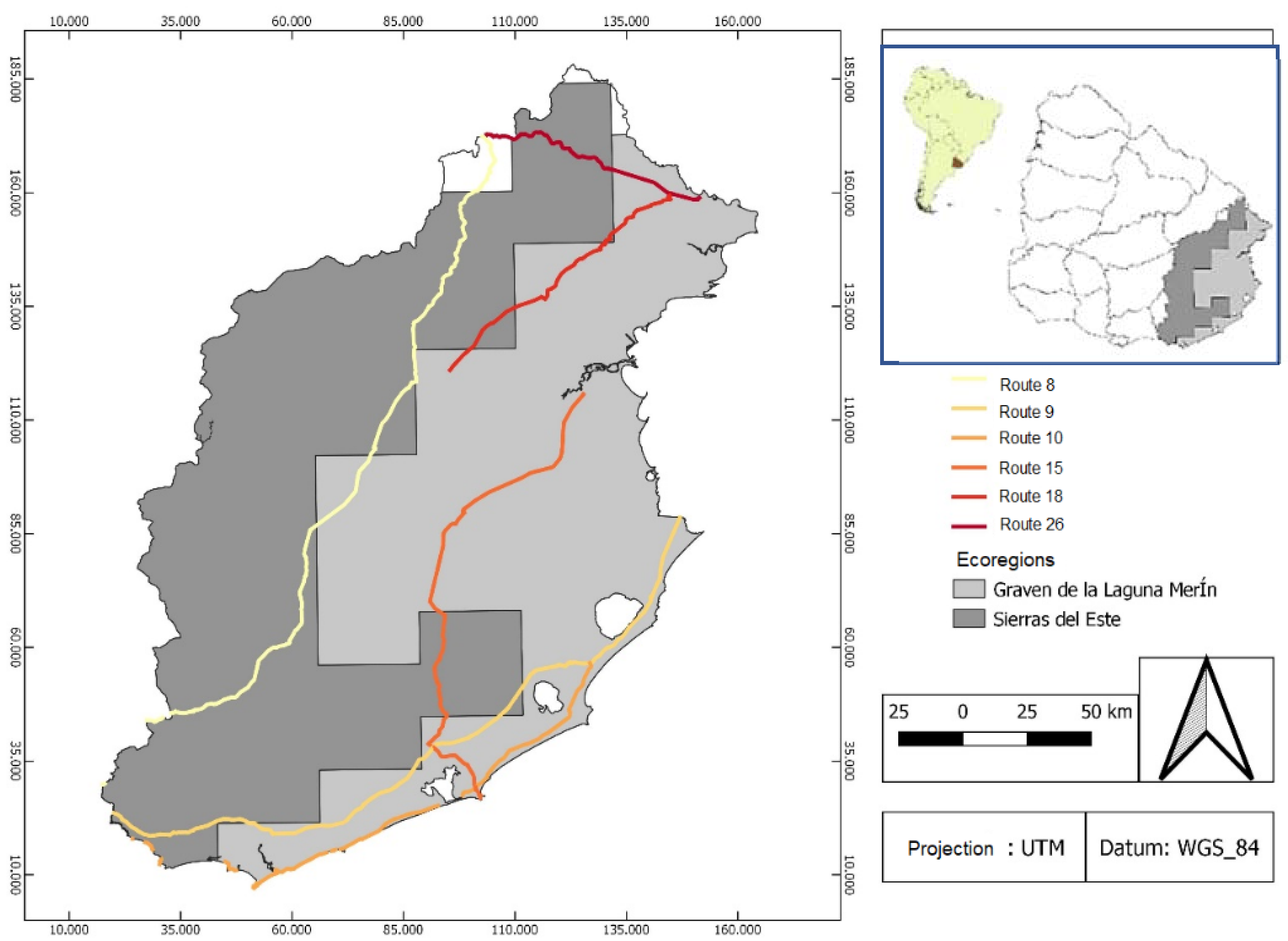

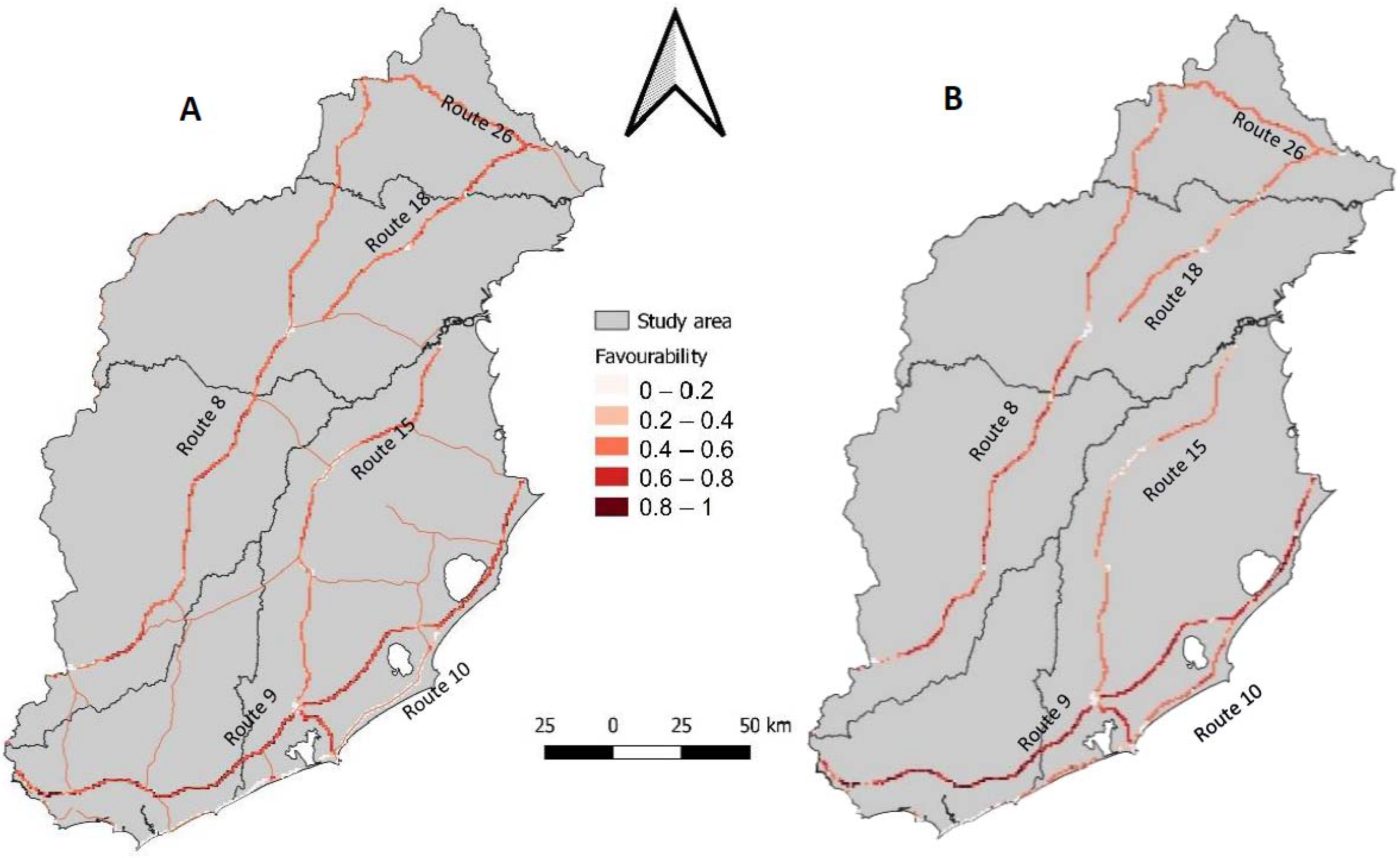
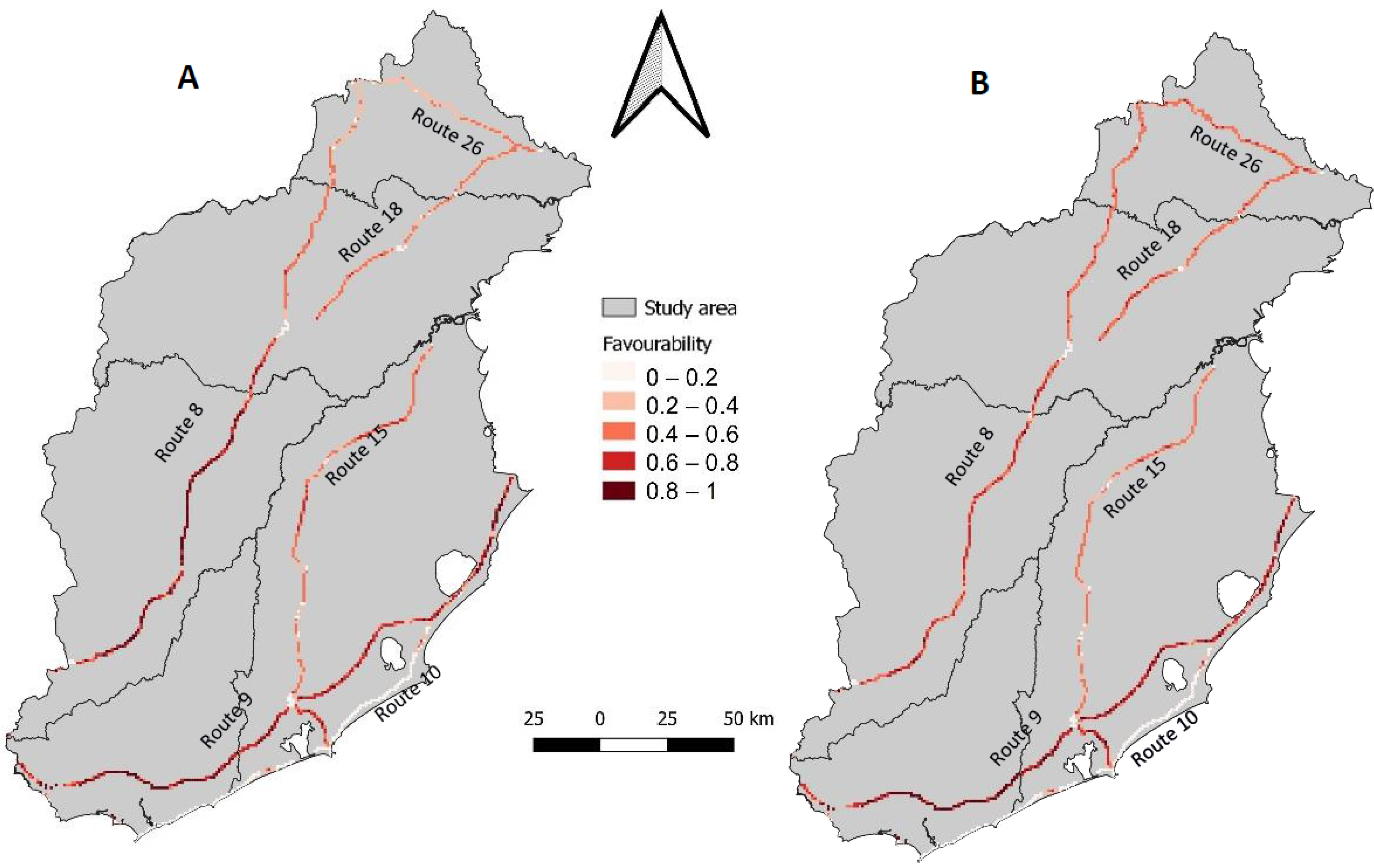
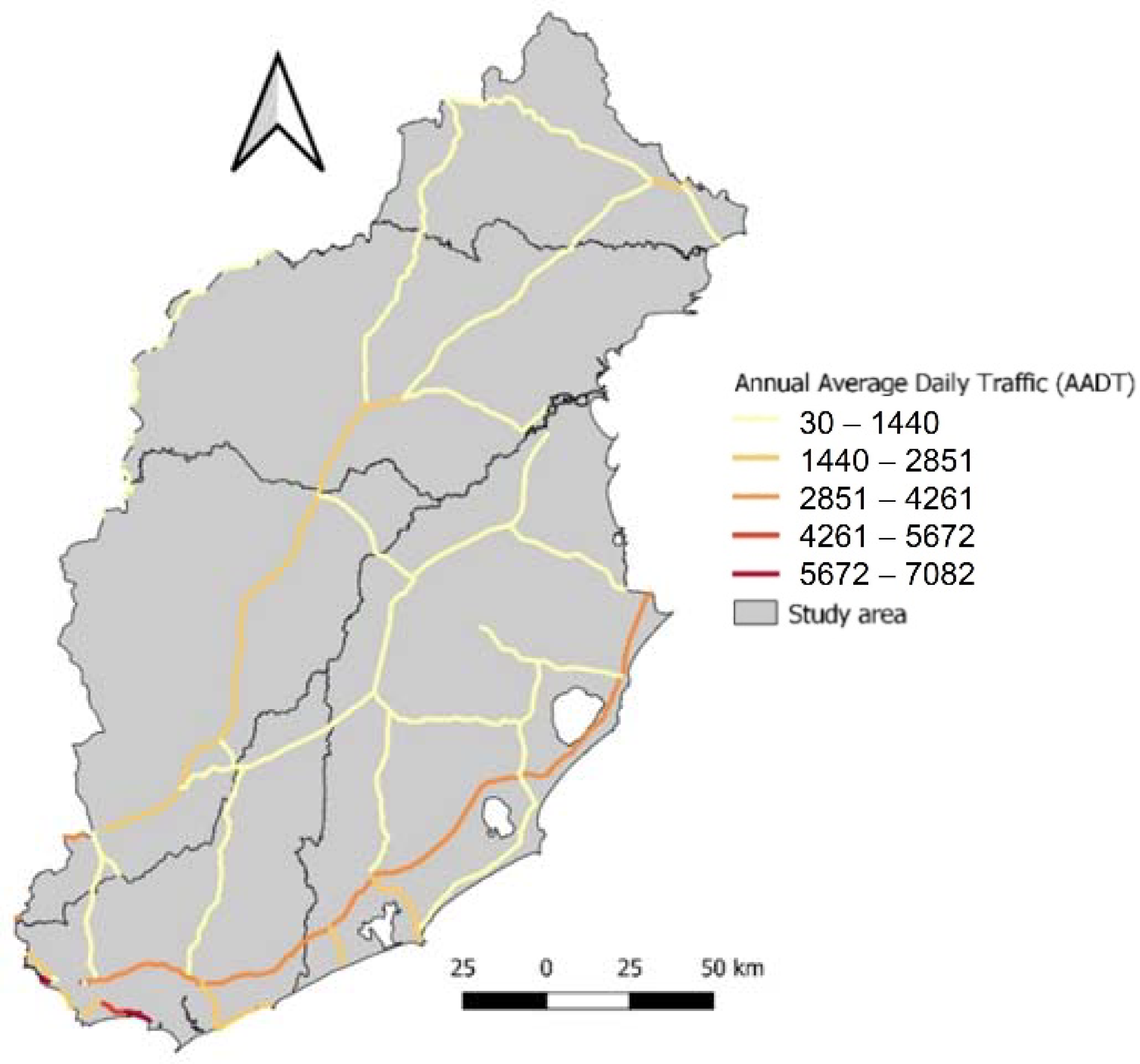
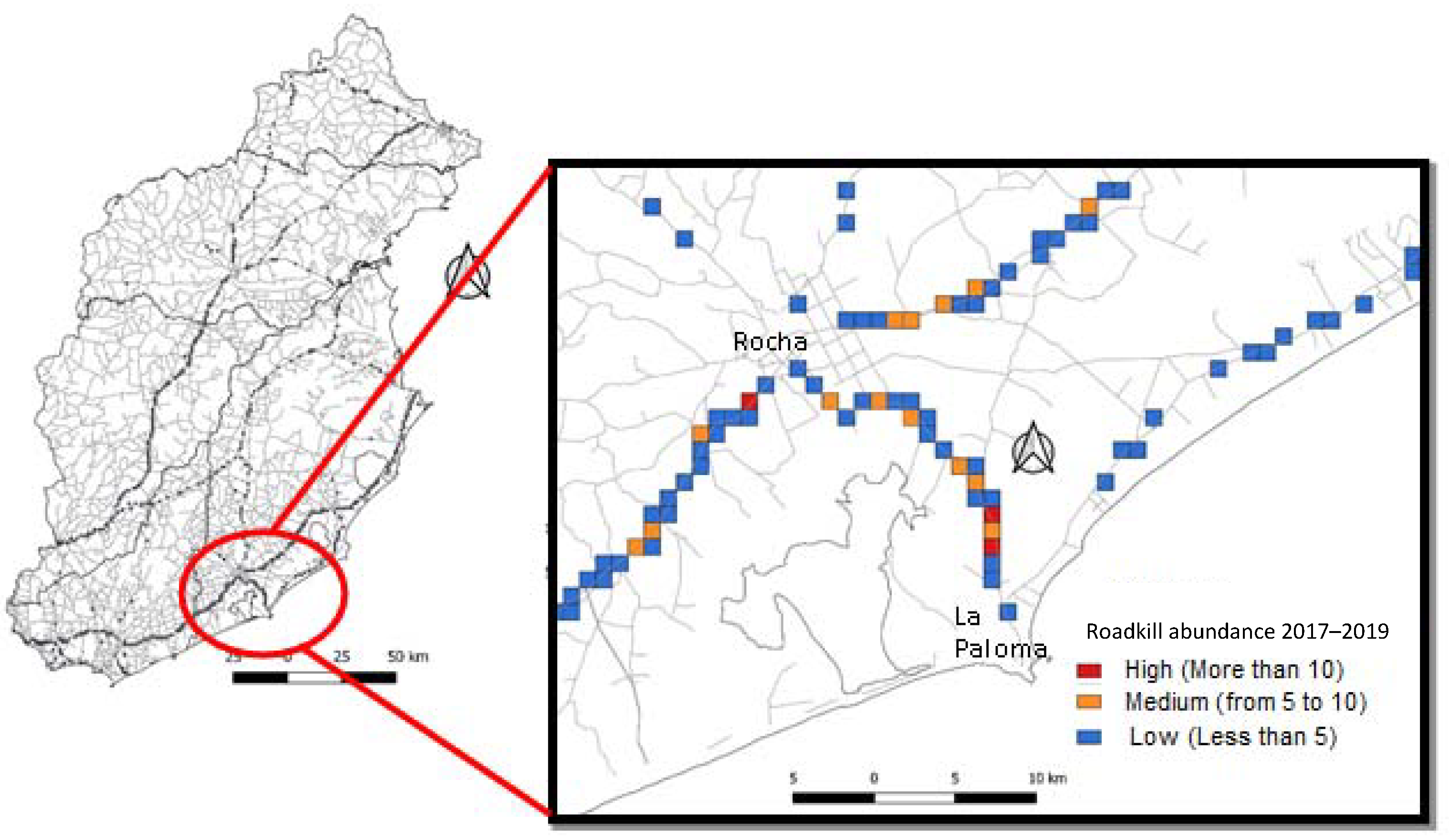
| Scientific Name | Common Name | Number of Roadkills | Status UICN | Weight (KG) |
|---|---|---|---|---|
| Cerdocyon thous * | Forest fox | 117 | LC | 8 |
| Procyon cancrivorus * | South American raccoon | 32 | LC | 8 |
| Dasypus novemcinctus * | Nine-banded armadillo | 16 | LC | 6 |
| Leopardus geoffroyi * | Geoffroy’s cat | 14 | LC | 6 |
| Lontra longicaudis * | Neotropical otter | 4 | NT | 8 |
| Leopardus wiedii * | Margay | 3 | NT | 3 |
| Conepatus chinga ** | Andes skunk | 347 | LC | 2 |
| Lycalopex gymnocercus ** | Gray pampean fox | 125 | LC | 4.6 |
| Dasypus hybridus ** | Southern long-nosed armadillo | 14 | NT | 2 |
| Galictis cuja ** | Lesser grison | 13 | LC | 2 |
| Explanatory Variable | Sign | Wald Index |
|---|---|---|
| Annual Average Daily Traffic (AADT) | + | 18.94 |
| Bridges | + | 9.12 |
| Urban | − | 6.6 |
| Land depth | + | 6.57 |
| Population density | − | 6.5 |
| Distance to roads | − | 4.23 |
| Annual Average Daily Traffic (AADT) | + | 31.91 |
| Urban | − | 10.95 |
| Roads | + | 5.96 |
| Population density | − | 4.7 |
| Explanatory Variable | Sign | Wald Index |
|---|---|---|
| Precipitation in the wettest quarter (BIO 16) | − | 24.38 |
| Urban | + | 21.85 |
| Annual Average Daily Traffic (AADT) | − | 21 |
| Roads | + | 17.5 |
| Average temperature in the wettest quarter (BIO 8) | − | 13.85 |
| Annual average temperature (BIO 1) | + | 11.22 |
| Population density | − | 9 |
| Distance to roads | − | 6.78 |
| Forestation | − | 5.89 |
| Precipitation seasonality (BIO 15) | − | 4.56 |
| Annual Average Daily Traffic (AADT) | + | 57.38 |
| Urban | − | 23.18 |
| Roads | + | 17.77 |
| Distance to roads | − | 7.66 |
| Forestation | − | 5.28 |
| Population density | − | 3.93 |
| AUC | CCR | Sensitivity | Specificity | TSS | UPR | OPR | |
|---|---|---|---|---|---|---|---|
| Complete model (forest sp.) | 0.76 | 0.65 | 0.78 | 0.63 | 0.42 | 0.038 | 0.80 |
| Complete model (Grassland sp.) | 0.78 | 0.70 | 0.75 | 0.45 | 0.69 | 0.093 | 0.58 |
| Anthropic model (forest sp.) | 0.72 | 0.67 | 0.63 | 0.67 | 0.30 | 0.059 | 0.81 |
| Anthropic model (Grassland sp.) | 0.77 | 0.67 | 0.79 | 0.43 | 0.64 | 0.088 | 0.61 |
Publisher’s Note: MDPI stays neutral with regard to jurisdictional claims in published maps and institutional affiliations. |
© 2021 by the authors. Licensee MDPI, Basel, Switzerland. This article is an open access article distributed under the terms and conditions of the Creative Commons Attribution (CC BY) license (https://creativecommons.org/licenses/by/4.0/).
Share and Cite
Coitiño, H.I.; Achkar, M.; Guerrero, J.C. Prediction of Sites with a High Probability of Wild Mammal Roadkill Using a Favourability Function. Diversity 2021, 13, 585. https://doi.org/10.3390/d13110585
Coitiño HI, Achkar M, Guerrero JC. Prediction of Sites with a High Probability of Wild Mammal Roadkill Using a Favourability Function. Diversity. 2021; 13(11):585. https://doi.org/10.3390/d13110585
Chicago/Turabian StyleCoitiño, Hugo Ignacio, Marcel Achkar, and José Carlos Guerrero. 2021. "Prediction of Sites with a High Probability of Wild Mammal Roadkill Using a Favourability Function" Diversity 13, no. 11: 585. https://doi.org/10.3390/d13110585
APA StyleCoitiño, H. I., Achkar, M., & Guerrero, J. C. (2021). Prediction of Sites with a High Probability of Wild Mammal Roadkill Using a Favourability Function. Diversity, 13(11), 585. https://doi.org/10.3390/d13110585






